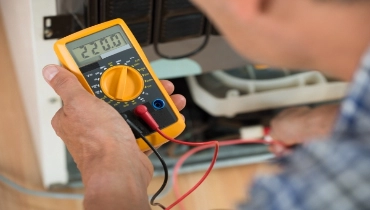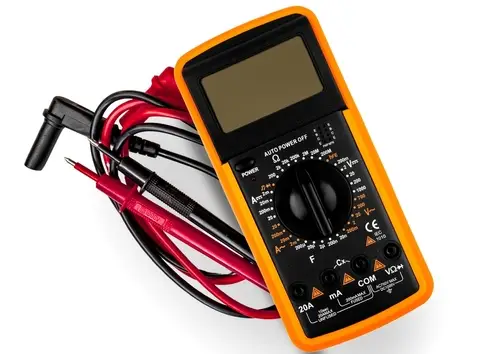
Mr. Electric explains how to safely use a multimeter to test voltage.
|
Multimeters check for live current in outlets, light switches, circuit breakers, car batteries, and other electrical components. The best part? You don’t have to be an electrician to master this handy tool! In this article, we’ll explain the purpose of a multimeter and how to use it to check voltage for both AC and DC applications while prioritizing safety. Let’s get started!
What Is a Multimeter?
A multimeter is a portable diagnostic tool primarily used to measure voltage, current, and resistance in an electrical circuit. Multimeters can also test continuity, diodes, and even more advanced measurements, such as capacitance or temperature.
There are two common types of multimeters:
- Digital Multimeter (DMM): Displays readings on a digital screen. DMMs are both simpler to use and more accurate than analog models, offering a wider range of features and greater flexibility for a variety of applications.
- Analog Multimeter: Uses a needle-based display. While typically less expensive than DMMs, analog multimeters are more difficult to read and offer fewer features. However, they can be more sensitive to minor fluctuations, which can be useful for detecting slow-moving changes in voltage or current.
When should you use a multimeter?
Multimeters have a wide range of uses, from testing household outlets to diagnosing a faulty light switch. Other common uses include:
- Diagnose a flickering light.
- Test a wall outlet or power strip.
- Confirm a tripped breaker.
- Rule out faulty wiring.
- Ensure power is off before installing electronics.
In the event of an electrical problem, a multimeter can give you a clearer picture of what’s going wrong. However, while a multimeter can help diagnose an electrical issue, it can’t resolve it. Always consult a qualified electrician before attempting electrical repairs.
How to Test AC Voltage With a Multimeter

Multimeters can test AC and DC currents. For most household applications, you’ll use the AC multimeter setting. Here's how to use a multimeter to check voltage in a typical 120-volt outlet, fixture, or light switch circuit.
How to test an outlet with a multimeter
Checking the voltage at an outlet is one of the most common uses for a multimeter. Before testing, ensure the device or circuit you're testing is turned off.
- Check the components.
- Before any testing, visually inspect all parts of the multimeter for damage (nicked or frayed wires or cracks in the unit).
- Ensure the testing area is dry.
- Turn on the multimeter.
- Rotate the dial to the Ṽ (or V~) symbol for AC multimeter testing.
- Set the range higher than the expected voltage (e.g., 200V for a 120V circuit).
- Insert the probes.
- Plug the black lead into the COM (common) port.
- Plug the red lead into the VΩmA port (for voltage testing).
- Test the probes.
- Touch the red and black tips together. Be sure to avoid touching them with your hands!
- If your reading is greater than 0.5 Ω (ohms), replace the probes.
- Test the circuit.
- Touch the black probe to the neutral (wide slot).
- Touch the red probe to the hot (narrow slot).
Your screen should display the voltage. For a standard U.S. outlet, expect a reading between 110–125 volts. There you go—you’ve successfully measured voltage with a multimeter!
Further reading about AC multimeter testing
Most AC components will follow the same steps as outlets. To learn more about using a multimeter, check out our handy guides:How to Test DC Voltage With a Multimeter
DC voltage is commonly used in power storage devices, such as car batteries and solar batteries. The steps to test DC voltage with a multimeter are the same for any application.
- Connect your red and black probes following the same steps listed above for AC voltage.
- Turn the mode switch of the multimeter to DC (VΩ or V–).
- Turn the voltage selector knob or button to the highest setting (30V). You can keep it there or work your way down until you get close to the actual voltage of whatever you’re testing.
- Touch the black probe to the negative terminal or side of the battery you’re testing.
- Touch the red probe to the positive terminal or side of the battery you’re testing.
- Remove the red and black probes from their slots and turn off your multimeter.
- It’s best practice to remove the red probe first, then the black one, but either order will do.
When to Call a Professional
If your multimeter detects unusually high or low voltage or no voltage at all, the cause may be a more complex electrical issue, such as:
- Faulty wiring
- A failing breaker
- Grounding issues
- Voltage drop across circuits
These scenarios require assessment and service by a qualified electrician. Your local Mr. Electric® team can diagnose and resolve the issue quickly.
Power in the Palm of Your Hand
Knowing how to use a multimeter empowers homeowners to gain an understanding of how electrical systems interact and power their daily lives. Whether you're testing a switch, outlet, circuit breaker, or car battery, using a multimeter to check voltage gives you the answers you need without relying on guesswork.
From outlet woes to flickering lights, Mr. Electric has the expertise to back you up. From expert troubleshooting to whole-home inspections, you never have to resolve electrical issues alone. Request an assessment from our trusted local electricians today.
This article is intended for general guidance only and is not applicable to every situation. You are responsible for determining the proper course of action for your property and situation. Mr. Electric is not responsible for any damages that occur as a result of advice and/or guidance derived from its blog content.
FAQs About Using a Multimeter
The safety of you, your family, and your home are the top priority of every Mr. Electric service professional. Our safety-first commitment to solving your electrical issues includes a meticulous attention to detail on every job. Our commitment also includes using our years of experience to answer your questions. Below are answers to some of the most frequently asked questions about how to use a multimeter.
What does a multimeter do?
A multimeter is a handheld device used to measure voltage, current, and resistance in electrical systems, diagnosing electrical problems safely and accurately. Electricians and homeowners use multimeters to troubleshoot outlets, switches, appliances, and circuit breakers.
What’s the difference between a multimeter and a non-contact voltage tester?
A multimeter and a non-contact voltage tester are both used to measure electrical properties, but they serve different purposes. A multimeter is a versatile tool that measures voltage, current, resistance, and more, providing detailed readings for troubleshooting and diagnostics. In contrast, a non-contact voltage tester detects the presence of voltage in wires or outlets without direct contact, offering a quick and safe way to check for electrical power.
- Functionality: Multimeters measure multiple electrical parameters (voltage, current, resistance, etc.), while non-contact voltage testers only detect the presence of voltage.
- Contact: A multimeter requires direct contact with the circuit, whereas a non-contact voltage tester can be used without touching the wire.
- Complexity: Multimeters offer detailed measurements, while non-contact voltage testers provide a simple indication of voltage.
- Safety: Non-contact testers are safer for quick checks as they don't require direct contact with live wires.
How do I use a multimeter to check voltage in an outlet?
To check outlet voltage with a multimeter:
- Insert the probes into the outlet slots (black into neutral, red into hot).
- Use the AC voltage setting (Ṽ or V~).
- Expect a reading between 110–125V.
If your results are outside this range, it may indicate a faulty outlet or wiring issue.
Can I measure DC voltage with a multimeter too?
Yes! Just switch the dial to the VΩ or V– setting for DC voltage. This is useful when testing batteries, solar panels, and other power storage devices. Always know whether you’re testing AC or DC to avoid errors.
Why is my multimeter not reading voltage?
Your multimeter may not read voltage due to the following:
- Dead multimeter battery
- Incorrect dial setting (AC vs DC)
- Faulty test leads
- No power in the circuit
Double-check your settings and test a known live outlet to verify your multimeter works properly.
What are common mistakes to avoid when using a multimeter?
These common multimeter errors can provide false or nonexistent readings:
- Setting the multimeter to amps (A) instead of volts (V)
- Using DC mode for an AC test
- Forgetting to check the multimeter's battery
- Touching the metal leads together while testing
Avoiding these mistakes will help you ensure safer, more accurate readings.

